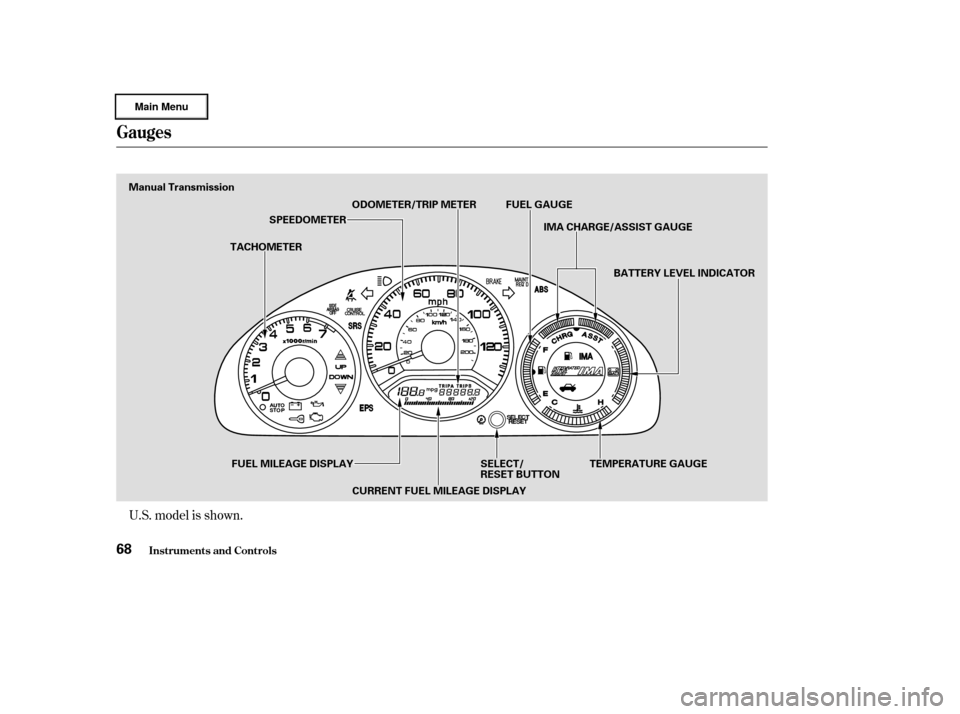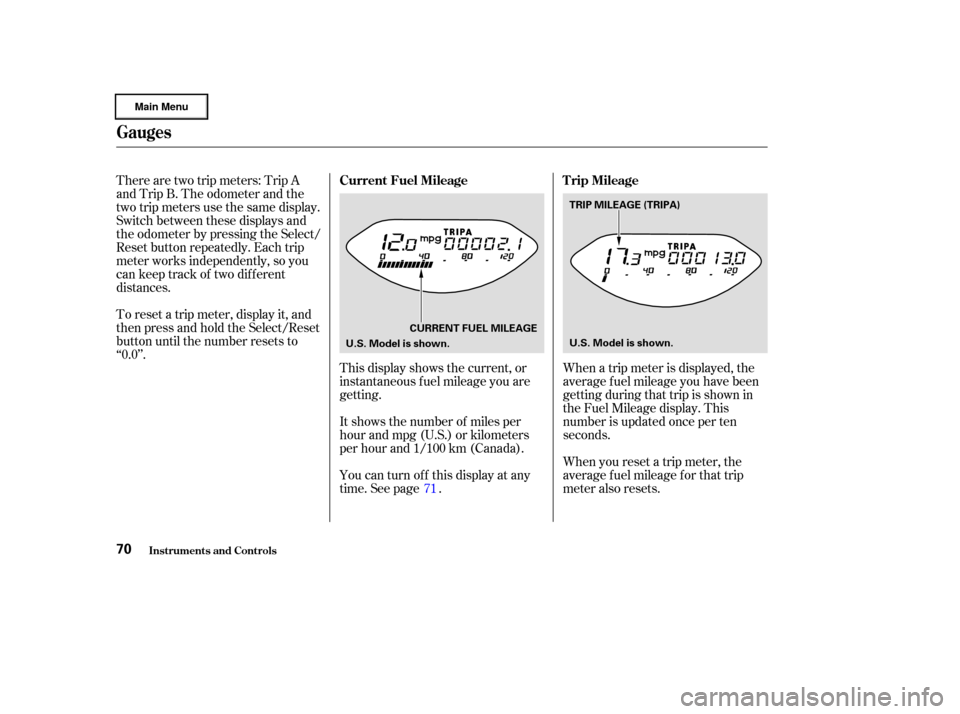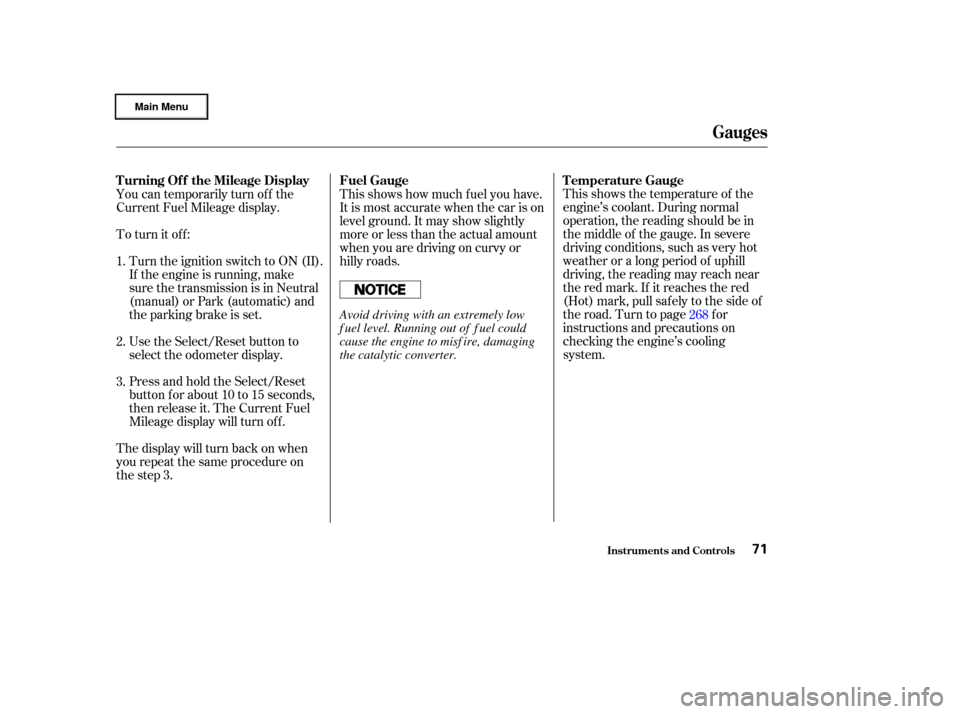2003 HONDA CIVIC HYBRID mileage
[x] Cancel search: mileagePage 60 of 317

This section gives inf ormation about
the controls and displays that
contribute to the daily operation of
your Honda. All the essential
controls are within easy reach............................
Control Locations .58 ...............................
Indicator Lights .59
.............................................
Gauges .67
...............................
Speedometer .69
.................................
Tachometer .69
...............
Odometer/Trip Meter . 69
.................
Current Fuel Mileage . 70
................................
Trip Mileage .70
Turning Of f the Mileage .....................................
Display .71
..................................
Fuel Gauge .71
...................
Temperature Gauge . 71
..................
Battery Level Gauge . 72
................
Charge/Assist Gauge . 73
Controls Near the Steering .......................................
Wheel .74
...................................
Headlights .75
............
Daytime Running Lights . 76
....
Instrument Panel Brightness . 77
................................
Turn Signals .78
.....................
Windshield Wipers .78
..................
Windshield Washers . 80
..........................
Hazard Warning .80
.............
Rear Window Def ogger . 81
......
Steering Wheel Adjustment . 82
...............................
Keys and Locks .83
..............................................
Keys .83 ....................
Immobilizer System . 84
............................
Ignition Switch .86
......................
Power Door Locks .87
...................
Remote Transmitter . 89
..............
Childproof Door Locks . 92
...........................................
Trunk .92
........
Emergency Trunk Opener . 93
............................
Seat Adjustments .94
.............
Front Seat Adjustments . 94
................
Driver’s Seat Armrest . 95
..........................
Head Restraints .96
..............................
Power Windows .97
.............................................
Mirrors .99
....
Adjusting the Power Mirrors . 99
...............................
Parking Brake .100
......................................
Glove Box .101
...........................
Beverage Holder .102
.................
Console Compartment . 102
........................................
Coin Box .103
...............................
Center Pocket .103
.............
Accessory Power Socket . 103
...............................
Interior Lights .104
..............................
Ceiling Light .104
...................................
Spotlights .104
................
Ignition Switch Light . 105
Instruments and Controls
Inst rument s and Cont rols57
Page 70 of 317

CONT INUEDU.S. model is shown.
Gauges
Inst rument s and Cont rols67
Automatic Transmission (CVT)TACHOMETERSPEEDOMETER
ODOMETER/TRIP METER
FUEL GAUGE
IMA CHARGE/ASSIST GAUGE BATTERY LEVEL INDICATOR
FUEL MILEAGE DISPLAY CURRENT FUEL MILEAGE DISPLAYSELECT/RESET
BUTTON
TEMPERATURE GAUGE
Page 71 of 317

U.S. model is shown.
Gauges
Inst rument s and Cont rols68
Manual TransmissionTACHOMETERSPEEDOMETER
ODOMETER/TRIP METER FUEL GAUGE
IMA CHARGE/ASSIST GAUGE
BATTERY LEVEL INDICATOR
FUEL MILEAGE DISPLAY CURRENT FUEL MILEAGE DISPLAY SELECT/
RESET BUTTON
TEMPERATURE GAUGE
Page 73 of 317

There are two trip meters: Trip A
and Trip B. The odometer and the
two trip meters use the same display.
Switch between these displays and
the odometer by pressing the Select/
Reset button repeatedly. Each trip
meter works independently, so you
can keep track of two dif f erent
distances.
To reset a trip meter, display it, and
then press and hold the Select/Reset
button until the number resets to
‘‘0.0’’.This display shows the current, or
instantaneous fuel mileage you are
getting.
It shows the number of miles per
hour and mpg (U.S.) or kilometers
per hour and 1/100 km (Canada).
You can turn off this display at any
time. See page .When you reset a trip meter, the
average fuel mileage for that trip
meter also resets. When a trip meter is displayed, the
average fuel mileage you have been
getting during that trip is shown in
the Fuel Mileage display. This
number is updated once per ten
seconds.
71
Inst rument s and Cont rols
Gauges
Current Fuel Mileage Trip Mileage
70
CURRENT FUEL MILEAGE
U.S. Model is shown. TRIP MILEAGE (TRIPA)
U.S. Model is shown.
Page 74 of 317

This shows the temperature of the
engine’s coolant. During normal
operation, the reading should be in
the middle of the gauge. In severe
driving conditions, such as very hot
weather or a long period of uphill
driving, the reading may reach near
the red mark. If it reaches the red
(Hot) mark, pull saf ely to the side of
the road. Turn to page for
instructions and precautions on
checking the engine’s cooling
system.
This shows how much f uel you have.
It is most accurate when the car is on
level ground. It may show slightly
more or less than the actual amount
whenyouaredrivingoncurvyor
hilly roads.
You can temporarily turn of f the
Current Fuel Mileage display.
To turn it off:
Turn the ignition switch to ON (II).
If the engine is running, make
sure the transmission is in Neutral
(manual) or Park (automatic) and
the parking brake is set.
Use the Select/Reset button to
select the odometer display.
Press and hold the Select/Reset
button f or about 10 to 15 seconds,
then release it. The Current Fuel
Mileage display will turn of f .
The display will turn back on when
you repeat the same procedure on
the step 3. 268
1.
2.
3.
Inst rument s and Cont rols
Temperature Gauge
Fuel Gauge
T urning Of f the Mileage Display
Gauges
71
Avoid driving with an extremely low
f uel level. Running out of f uel could
cause the engine to misf ire, damaging
the catalytic converter.
Page 147 of 317

During this period:Avoid full-throttle starts and rapid
acceleration.
Avoidhardbraking.Newbrakes
need to be broken-in by moderate
use f or the f irst 200 miles (300
km). Your Honda is designed to operate
on unleaded gasoline with a pump
octane number of 86 or higher. Use
of a lower octane gasoline can cause
a persistent, heavy metallic rapping
noise in the engine that can lead to
mechanical damage.
We recommend gasolines containing
detergent additives that help prevent
f uel system and engine deposits.
In Canada, some gasolines contain
an octane-enhancing additive called
MMT. If you use such gasolines,
your emission control system
perf ormance may deteriorate and
the Malf unction Indicator Lamp on
your instrument panel may turn on.
If this happens, contact your
authorized Honda dealer f or service.
Help assure your car’s f uture
reliability and perf ormance by paying
extra attention to how you drive
during the f irst 600 miles (1,000 km).
Using gasoline containing lead will
damage your car’s emissions
controls. This contributes to air
pollution.
Youshouldfollowthesesamere-
commendations with an overhauled
or exchanged engine, or when the
brakes are relined. Do not change the oil until the
recommended time or mileage
intervalshowninthemaintenance
schedule.
Break-in Period, Gasoline
Bef ore Driving
Break-in Period
Gasoline
144
Page 153 of 317

The condition of your car and your
driving habits are the two most
important things that affect the fuel
mileage you get.
Always maintain your car according
to the maintenance schedule. This
will keep it in top operating condition.
An important part of that mainte-
nance is the(see page ). For
example, an underinf lated tire
causes more ‘‘rolling resistance,’’
which uses f uel. It also wears out
f aster, so check the tire pressure at
least monthly. You can improve f uel economy by
driving moderately. Rapid acceler-
ation, abrupt cornering, and hard
braking use more f uel.
To get the best f uel mileage, drive in
the highest gear that is practical for
the speed you are driving, and
always accelerate slowly.
Engine oil also af f ects f uel economy.
The f uel ef f icient, low-viscosity
0W-20 oil recommended f or your
Civic Hybrid is f ormulated to help
the engine use less f uel. This oil is
available at your Honda dealer.
In winter, the build-up of snow on
your car’s underside adds weight and
rolling resistance. Frequent cleaning
helps your f uel mileage and reduces
the chance of corrosion.
You may f ind that your Civic Hybrid’s
unique combination of an engine and
an electric motor has driving
characteristics that are somewhat
dif f erent f rom what you are used to.
Shif t Up and Shif t Down indicators
(5-speed manual transmission only)
on the instrument panel show when
to shif t to a higher or lower gear. By
shifting as soon as the indicator
comes on, you will keep the engine
operating in its most economical
range.
193
Vehicle Condition
Owner Maintenance
Checks Driving Habits
Bef ore Driving
Fuel Economy
150
Page 154 of 317

The air conditioning puts an extra
load on the engine which makes it
usemorefuel.Turnoff theA/Cto
cutdownonairconditioninguse.
Use the f low-through ventilation
when the outside air temperature is
moderate.
If air conditioning is needed, you can
save some f uel by using the A/C in
‘‘ECON’’ mode. When the outside
temperature is above 41°F (5°C),
this mode allows the Auto Idle Stop
f unction to shut of f the engine when
the vehicle is stopped, resulting in
fuel savings.
Depending on traf f ic conditions, try
to maintain a constant speed. Every
time you slow down and speed up,
your car uses extra f uel. Use the
cruise control, when appropriate, to
increase f uel economy.
Wind resistance causes vehicles to
usemorefuelathigherspeeds.
Driving at moderate speeds on the
highway reduces wind resistance
and conserves f uel.
A cold engine uses more f uel than a
warm engine. It is not necessary to
‘‘warm-up’’ a cold engine by letting it
idle f or a long time. You can drive
away in about a minute, no matter
how cold it is outside. The engine
will warm up f aster, and you get
better f uel economy. To cut down on
the number of ‘‘cold starts,’’ try to
combine several short trips into one. You may notice that using the A/C
causes a greater drop in f uel
economy than you are used to in
other vehicles. Although the amount
of extra f uel used by the A/C load on
the engine is no greater than other
vehicles, it is more noticeable
because of your Civic Hybrid’s
excellent f uel mileage. Using the
A/C in hot weather may result in
f uel economy that is lower than
expected.
Fuel Economy
Bef ore Driving151